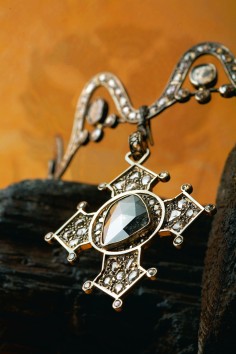
Greek-born jewellery maker Vassiliki looks to the past for inspiration
As heiress and torchbearer of her family's centuries-old art and culture house, Greek-born jewellery maker Vassiliki seeks inspiration from the past for her creations, writes Kylie Knott
Statuesque models in white Grecian-style dresses sail by, chunky gold jewellery on their necks and wrists. Layers of velvet in rich gold, blue and red are draped casually over the furniture and around the glass cabinets that house an impressive collection of handmade gold jewellery, one-of-a-kind pieces that tread a fine line between art and fashion.

Then the serene almost spiritual scene comes to a screeching halt as Vassiliki Theodorakidi-Mamona enters the room, her talkative entourage trailing behind her.
The charismatic and chatty Greek artist is modestly dressed in a black turtleneck, black trousers and knee-high cream boots. She is, surprisingly, lacking in bling. The room - the Adante Gallery in Central's Duddell Street - has been converted into a shrine of her extraordinary work, which, for this collection, has been inspired by the Byzantine and Russian cultures (the exhibit has now relocated to Red Square Gallery in Stanley where it will run until May 31).
"It's always so amazing to be in Hong Kong. My family has always had a very strong relationship with the East, with the silk and the gold trades. They kept strong connections in the Far East by having the silk monopoly during the Byzantine period through the Silk Road," she says through an interpreter.
The family she is referring to is one with Byzantine roots that can be traced back to 13th-century Greece. Her cultural and family background is a huge source of inspiration, and the family's coat of arms is now the logo for her fashion house.
As the heiress and torchbearer of her family's art and culture house, Thyreos Vassiliki, Vassiliki, who, as an artist, goes by her first name, continues the family's tradition of gold craftsmanship, specialising in exquisite handcrafted jewellery creations made of 18-, 22-, and 24-carat gold. And exquisite they are: each piece is fit for a queen.
A bejewelled snake set includes a bracelet, ring, necklace and earrings all in 18-carat gold and set with rubies and rose-cut diamonds and a gold pendant and earrings embedded with original coins. Taking pride of place is a perforated bracelet inspired by the ornamental handle of an ancient dagger and a gold bracelet with a diamond motif from her "Royal Collection".

Her religious icons, which feature the Virgin Mary, Jesus Christ, St George, and John The Baptist depicted in various well-known scenes, have all been hand-painted on sacred wood using traditional egg tempera painting techniques.
The Last Supper, which shows Christ and his disciples, is covered in silver detailing, and only the faces are free from embellishment. This is particularly captivating, as is a composition of Byzantine hagiographies which shows scenes from the Old and New Testaments.
"I see history as art, so I like to look to the past and bring it to the present. Jewellery is a form of art, a micro sculpture that carries messages and emotions. An art piece is not valued according to weight but by the sentiment it evokes," she says.
The diminutive artist, whose work has been shown around the world, may be small, but what she lacks in centimetres is more than compensated for by her charisma. She instils passion in her works, a trait often lacking in the world of mass production.
"I am trying to restore the role of jewellery as a piece of timeless value, beyond commercial and impersonal fashion trends; a way for someone to express themselves, and their character, as a jewel as an art piece.
" I make sure I have a strong connection to my work. For me, each piece is like a piece of my heart - like one of my children. I have created each piece with my hand, so I cannot say that I love one piece more than another, as they have all been created with passion and love."
For her pieces, she draws on ancient and modern history and mythology. "Greece has a long history of gold craftsmanship and this is a tradition I have continued. I have also continued using traditional craftsmanship techniques … Every piece is unique and so every piece will find its owner.

Right on cue, a woman walks into the gallery and promptly buys four pieces from the collection, despite being told she can't take them straight home because they are part of an exhibition. After parting with a substantial sum of money, she asks for a photo with the artist.
As she poses with Vassiliki, it's impossible not to be sceptical about how much client relationship building can be achieved in a city where shopping is often equated with religion, and where the consumer reigns supreme.

